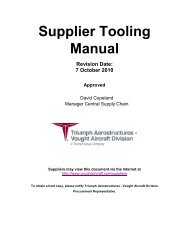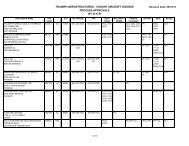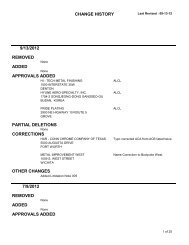SIP Summary Plan Description - Vought Aircraft Division
SIP Summary Plan Description - Vought Aircraft Division
SIP Summary Plan Description - Vought Aircraft Division
Create successful ePaper yourself
Turn your PDF publications into a flip-book with our unique Google optimized e-Paper software.
Schwab Personal Choice Retirement Account<br />
The Personal Choice Retirement Account (PCRA), offered through Charles Schwab & Co. Inc.<br />
(member <strong>SIP</strong>C), provides access to no-load mutual funds. No-load mutual funds do not have<br />
transaction fees for buying into the mutual funds, but other fees apply to open and maintain an<br />
account. The PCRA is a self-directed brokerage account in which the <strong>SIP</strong> participant selects<br />
among the available universe of Schwab no-load mutual funds. Charles Schwab & Co.<br />
determines which no-load funds are available. The PCRA is for knowledgeable investors who<br />
seek a greater role in managing their retirement savings.<br />
The individual participant must assess the risks and characteristics of any mutual fund and how<br />
that fund fits with the participant’s other investments and goals. Additional information about<br />
benchmarks and historical performance of funds chosen through the PCRA may be obtained<br />
through Schwab.<br />
You may invest up to 75% of your account in the PCRA.<br />
Units and Unit Values<br />
When you invest in the <strong>SIP</strong> investment funds, your contributions purchase “units” of each fund.<br />
The value of your account depends on the number of units that your contributions purchase, as<br />
well as on the current value of each unit. Unit values are determined for each fund based on the<br />
total return of the fund less any fees and expenses paid by the <strong>SIP</strong>. For more information about<br />
<strong>SIP</strong> fees and expenses, please see the <strong>Summary</strong> Annual Report that is mailed to participants at<br />
the end of each year.<br />
When a fund is established, its units are assigned an arbitrary value – for example, $1. If you<br />
contributed $10 to the fund at that time, your account would have been credited with 10 units.<br />
See the chart below for a breakdown of how unit values are calculated.<br />
YOUR $10 CONTRIBUTION ÷ THE $1 UNIT VALUE = 10 UNITS<br />
Your account now has 10 units<br />
Then suppose that during the first week the fund earns 10%.<br />
10% x $10 = $1<br />
This means that your $10 initial contribution increases by $1 and is worth $11.<br />
$1 + $10 = $11<br />
Because you still have 10 units in the fund,<br />
The new unit value is $1.10 (the $11 account<br />
value divided by 10 units).<br />
$11 ÷ 10 = $1.10<br />
If you purchase additional units at this time,<br />
You pay $1.10 for each.<br />
22








